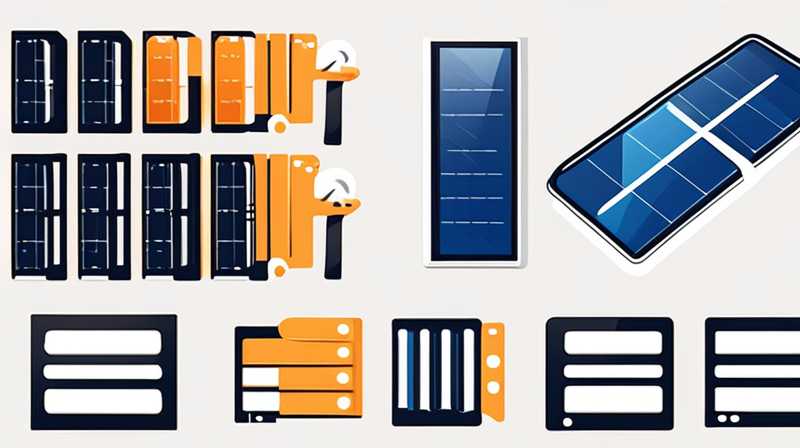
1. INSTALLATION REQUIREMENTS: When considering the implementation of solar brackets, several key materials must be procured to ensure a stable foundation. These items include stainless steel bolts, brackets specifically designed for solar panels, and mounting rails. Proper selection of materials whose corrosion resistance, load capacity, and compatibility with the solar panel system are essential for a long-lasting installation. Furthermore, understanding local building codes and regulations surrounding the installation of solar energy systems is pivotal to ensure compliance, durability, safety, and optimal performance of the solar array.
2. TOOLS AND EQUIPMENT: Proper tools are fundamental when executing the installation of solar brackets. Essential tools include a power drill, wrenches, level, measuring tape, and safety equipment such as gloves and goggles. Utilizing these tools not only enhances efficiency but also ensures quality throughout the installation process. Incorrect usage or absence of the right tools can lead to improper installation, creating daunting challenges in the future. Therefore, assembling an adequate toolkit ahead of time enhances preparedness and smoothens the workflow during the mounting procedure.
3. SITE PREPARATION: Before commencing with the installation of solar brackets, thorough site preparation is paramount. Selecting an appropriate location on the roof or ground is critical, as this area must receive maximum sunlight exposure throughout the day. Factors such as the orientation and tilt angle of the panels must be considered, as both elements significantly impact the solar system’s energy generation efficiency. Ensuring that the area is free from obstructions like trees, chimneys, or adjacent buildings which may cast shadows is vital for maximum solar irradiance capture.
4. MOUNTING TECHNIQUES: Familiarizing oneself with different mounting techniques is crucial for a successful solar bracket installation. These methods vary based on the roof type: for flat roofs, ballasted systems may be employed, while pitched roofs often use penetration mounts secured to the roof. Understanding specific techniques allows for customization, meeting individual project needs efficiently. Emphasis should be placed on ensuring that brackets are anchored to structural components of the building to withstand environmental factors such as wind and snow loads.
5. INSTALLATION STEPS: Proceeding with the installation involves systematically steps to ensure a quality outcome. Initially, establish anchor points for the brackets and adjust their spacing according to the panel layout. Following this, drill holes carefully into the selected surface, ensuring that the structure remains intact and seal these penetrations effectively to prevent water ingress. After confirming the brackets’ levelness, secure the mounting rails and attach the solar panels, adhering to manufacturers’ specifications and guidelines.
6. FINAL INSPECTION: Upon completing the installation, conducting a comprehensive final inspection is crucial. This includes verifying that all connections are secure and that there is no misalignment in the installed system. Ensuring the angle of solar panels promotes optimal sunlight exposure is also vital. Post-installation, check for any loose hardware or other possible issues that may hinder performance. This meticulous approach guarantees a robust system ready for operation and poised to harness solar energy effectively.
FREQUENTLY ASKED QUESTIONS
IS PROFESSIONAL INSTALLATION NECESSARY FOR SOLAR BRACKETS?
While it is possible to undertake the installation of solar brackets personally, engaging a professional contractor is often advised due to the complexity and safety concerns involved. Solar energy systems involve significant investment and adherence to local building codes crucial for efficient and safe operations. This ensures not only compliance with regulations but also that the correct techniques and materials are used. In many instances, contractors provide warranties that safeguard your investment against unforeseen issues. Moreover, professional services might offer insights on the ideal configurations and placements tailored to local weather patterns, optimizing performance and longevity. Planning for eventualities like maintenance assistance or troubleshooting is easier when working with experts familiar with the nuances of solar energy installations.
HOW LONG DOES THE INSTALLATION OF SOLAR BRACKETS TAKE?
The duration for installing solar brackets varies based on multiple factors, including the complexity of the setup, the type of solar panel system, and the experience level of the installer. On average, a standard residential installation could take between one to three days provided there are no significant environmental or structural challenges. Larger systems involving multiple panels or unique configurations may require longer timeframes. Efficiency is often realized through proper planning, ensuring that all tools and materials are prepped, significantly reducing delays. Moreover, weather conditions play a crucial role in the timeline; unfavorable weather can postpone the installation, necessitating contingency plans for smooth operations.
WHAT MAINTENANCE IS REQUIRED AFTER INSTALLATION?
Post-installation maintenance is integral to sustaining optimal performance of solar energy systems. Essential upkeep involves regular examinations of brackets and mounting hardware for signs of wear or corrosion, particularly in areas exposed to harsh weather conditions. Cleaning panels periodically, in order to remove debris or dust accumulation that could obstruct sunlight access, enhances energy efficiency. Additionally, monitoring the electrical connections for any loose wiring or signs of damage is crucial to ensure safety and productivity. Engaging in annual professional assessments warrants comprehensive checks covering all installation elements, providing peace of mind while identifying potential issues before they escalate into significant problems.
IMPLEMENTATION OF SOLAR BRACKETS REQUIRES DILIGENCE AND ATTENTION TO DETAIL: Ensuring each phase from preparation to execution is carried out meticulously shapes the success of the project. Understanding both the technical and regulatory aspects of installing solar brackets highlights the importance of thorough planning and execution. Engaging with professionals when necessary mitigates risks associated with improper installation and maximizes the energy harnessing potential of solar systems. Following these comprehensive directives guarantees a sustainable energy solution that leverages the power of the sun while ensuring compliance, safety, and durability over its operational lifespan.
Original article by NenPower, If reposted, please credit the source: https://nenpower.com/blog/how-to-install-solar-bracket-3/


